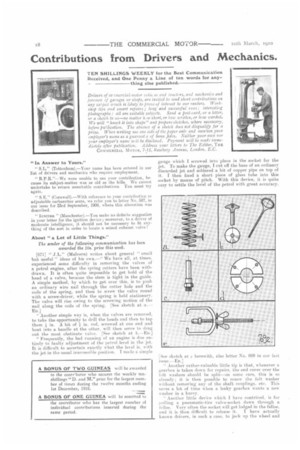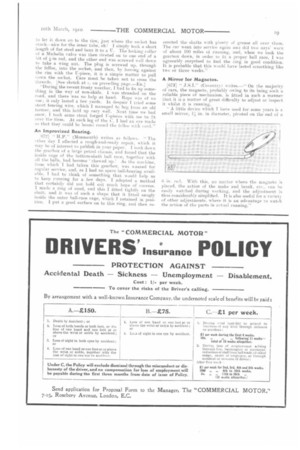Contributions from Drivers and Mechanics.
Page 18

Page 19

If you've noticed an error in this article please click here to report it so we can fix it.
EN SHILLINGS WEEKLY for the Best Communication Received, and One Penny a Line of ten words for any thing else published
Drivers of ccrumercial-motor vehie.e.s and tractors, and mechanics and foremen (1 garages or shops, are invited to send short contributions on any subject winch is likely to prove of interest to our readers. Workshop tips and smart repairs ; long and successful runs ; interesting Photographs : all are suitable subjects. Send a post .card, or a letter, or a sketch to us—no matter 'Lao short, or how written, or how worded. We will "knock it into shape" and prepare sketches, where necessary, before predication. The absence of a sketch dues not disqualify for a prize. When writing use one side of the paper only and mention your employer's more as a guarani.e of bona fides. Neither your own nor your employer's name will be disclosed. Payment will be made immediately after publication. Address your letters to The Editor, THE COM M ERCIAL Morokt, kosebery Avenue, London, E.C.
"In Answer to Yours."
" S.L." (Tottenham).—Your name has been entered in our list of drivers and mechanics who require employment.
" R.P.R."—We were unable to use your contribution, because its subject-matter was as old as the hills. We cannot undertake to return unsuitable contributions. You must try again.
" S.E." (Cornwall).—With reference to your contribution re adjustable carburetter seats, we refer you to letter No. 587, in our issue for 23rd September, 1909, where this alteration was described. "
IGNITER" (Manchester).—You make no definite suggestion in your letter for the ignition device; moreover, to a driver of moderate intelligence, it should not be necessary to fit anything of the sort in order to locate a seized exhaust valve !
About "a Lot of Little Things."
The sender of the following communication has been awarded the 101. prize this week.
[671] " J.L." (Malvern) writes about general " small but useful " ideas of his own.—" We have all, at times. experienced some difficulty in removing the valves of a petrol engine, after the spring cotters have been withdrawn. It is often quite impossible to get hold of the head of a valve, because the stem is tight in the guide. A simple method, by which to get over this, is to push an ordinary wire nail through the cotter hole and the coils of the spring, and then to screw the valve round with a screw-driver, while the spring is held stationary. The valve will rise owing to the screwing motion of the nail along the coils of the spring. [See sketch at a. ED.]
" Another simple way is, when the valves are removed, to take the opportunity to drill the heads and then to tap them in. A bit of in. rod, screwed at one end and bent into a handle at the other, will then serve to drag out the most obstinate valve. [gee sketch at b.—ED.] " Frequently, the bad running of an engine is due entirely to faulty adjustment of the petrol level in the jet. It is difficult to ascertain exactly what the level is, with the jet in the usual inaccessible position. I made a simple gauge which I screwed into place in the socket for the jet. To make the gauge, I cut off the base of an ordinary discarded jet and soldered a bit of copper pipe on top of it. I then fixed a short piece of glass tube into this socket by means of pitch. With this device, it is quite easy to settle the level of the petrol with great accuracy.
.to let it down on to the tire, just where the socket has stuck—nue for the inner tube, eh I simply took a short length of flat steel and bentit to a U. The locking collar ot a Michelin valve was then riveted on to one end of a bit of rod, and the other end was screwed well down to take a wing nut. The plug is screwed up, through the felloe, into the socket, -and then, by forcing against the rim wit-h the U-piece, it is a simple matter to pull down the socket. Care must be taken not to cross the threads. [See sketch at c, on preceding page.—ED.1 "During the recent frosty weather, I had to fix up something in the way of non-skids. I was stranded on the road, and there was no help at hand. Rope was of no use; it only lasted a few yards. In despair I tried sonic stout fencing wire, which I managed to beg from an old farmer., and this held up very well. Next time we had snow, I took some stout forged IT-pieces with me to fit over the tires. At each leg of the C, I had an eye made so that they could be boluni round the fain! with cord."
An Improvized Bearing.
:6721 " H.P." (Monmouth) writes as follows. " The other day I effected a rough-and-ready repair, which it may be of interest to publish in your paper. 1 rook down the gearbox of a large petrol chassis, and found that the inside cage of the bottom-shaft ball race, together with all the balls, had become chewed up.' As the machine, from which T. had taken this gearbox, was wanted for regular service, and, as I had no spare ball-bearing available, T had to think of something that would help us to keep running for a few days. I ad-opted a method that certainly did not hold out much hope of success. I made a ring of steel, and this I fitted tightly on the shaft, and itwas of such a shape that it fitted snugly inside the outer ball-race cage, which I retained in position. I put a good surface on to this ring. and then re erected the shafts with plenty of grease all over them. The car weut into service again and did two nays' work of about 100 miles of running, and, when we took the gearbox down, in (order to lit a proper ball race, I was agreeably surprised to find the ring in good condition. It is probable that this would have lasted something like two or three weeks."
A Mirror for Magnetos.
[6731 " J.S.I." tCOV ent ry writes.—" On the majority of cars, the magneto, probably owing to its being such a reliable piece of mechanism, is fitted in such a manner that it is a matter of great difficulty to adjust or inspect it whilst it is running.
" A little device which I have used for some years is a small mirror, I.?, in. in diameter, pivoted on the end of a 0 in. vol. With this, no matter where the magneto is placed, the action of the make and break, etc.. can be easily watched during working, and the adjustment is thus considerably simplified. It is also useful for a variety of other adjustments, where it is an advantage to watch the action of the parts in actual running."




















